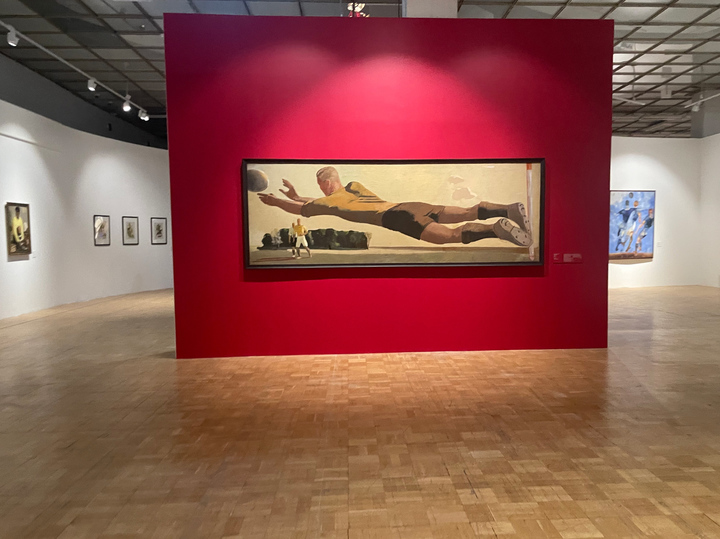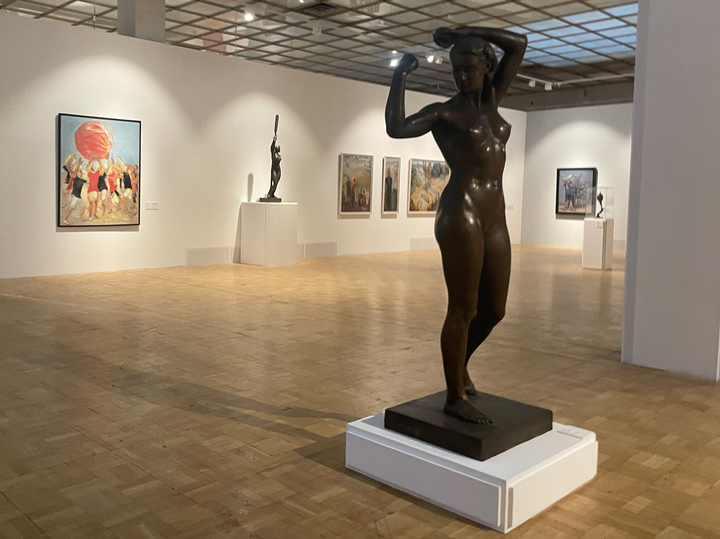The exhibition “Century of Sports” in the Tretyakov Gallery returned to the Soviet paradise
[ad_1]
At the “Century of Sports” exhibition in the West Wing of the Tretyakov Gallery, where more than 150 works from 15 museums are collected, you expect to see “athletic” art from different times and different styles – over a century. And in vain. The focus here is Alexander Deineka, Alexander Samokhvalov, Yuri Pimenov and their consonant socialist realism with a rare touch of avant-garde. That is, Soviet sport – in all its clarity and obviousness.
The exhibition is timed to coincide with the signing of the decree on the formation of the Councils of Physical Culture of the Workers of the RSFSR (essentially, the Ministry of Sports), which took place on June 23, 1923. After which, in the vastness of the early Soviet state, propaganda of a healthy lifestyle unfolded, which was taken up by workers with sincere zeal.
The first decision of the newly formed physical education council was the resolution on holding the All-Russian holiday of physical education and sports. The holiday was held as part of the All-Russian Agricultural and Handicraft Exhibition, for which a pavilion and the first stadium in the USSR were built in the vacant lot where the West Wing of the Tretyakov Gallery is now located. He held this position until the late 1930s.
Actually, this period is the focus. The exhibition opens with a lightbox with a reproduction of Alexander Samokhvalov’s painting “Girl in a T-shirt” from 1932, glowing under the red slogan: “The whole country is our stadium.”
In a dark corner opposite her, Aristarkh Chernyshev’s scoreboard with text about sports, twisted into a knot, stands forlornly. This introduction – intentionally or not – sets the tone for the exhibition, where contemporary art finds itself on the margins, and unforgettable Soviet art rules the roost.

There are only two things here from the post-Soviet era: in addition to Chernyshev’s work, on the facade of the Tretyakov Gallery, which overlooks the embankment, there is a mural by street artists of the “New Wave”. Quite formal.
The exhibition itself takes us to the Soviet sports paradise. The exhibition is designed as if we were in a stadium – with large arched spans and spatial solutions characteristic of Soviet architecture.
There are nine halls in total. The central one is the largest and resembles an arena. Each section has its own sport: football, gymnastics, athletics, shooting, wrestling, skating, chess… None of them could do without the excellent works of Deineka, Samokhvalov and Pimenov, who not only painted the sports theme, but also spent a lot of time themselves at stadiums. For example, Yuri Pimenov played football and was an avid fan, and Alexander Deineka was involved in boxing. All the Soviet classics are before us – here are Georgy Nissky and Viktor Popkov…

The presence of the painting “Deuce Again” by Fyodor Reshetnikov, widely known from Soviet textbooks, may seem unexpected. However, only at first glance. If you look closely at the briefcase of a boy ashamed for his poor academic performance, you will see skates sticking out of it. The student got a bad grade by skipping classes for the sake of sports.
From the description you can find out that many neglected their lessons for the sake of sports, and adults, headlong after work, ran with their skates onto the ice, or into the pool, or to the chess table. The passion for sports was massive and total. At least, this conclusion follows from the diversity presented.
It seems that the latest work in the exhibition belongs to the brush of Sergei Sherstyuk and depicts a cyclist racing in only shorts and sneakers, with a player in his ears. That is, in fact, we are not facing a century of sports, but several decades of Soviet sports. It turns out that the title does not reflect the content. It would be worth calling the exhibition “The Century of Soviet Sports” or simply “Soviet Sports”.
Why did modernity fail? Perhaps the projects that were born after the collapse of the USSR did not fit into the concept of the exhibition, because most of them are somewhat broader than sports, they also touch on social issues, and are burdened with conflict and conceptual overtones, which clearly turned out to be superfluous here. Here is a celebration of sports, a cult of the body, Olympic scope and height. In a word, the correct semantics is a slogan that sounds in the right way today.
[ad_2]
Source link






